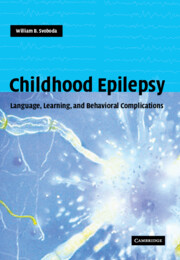Book contents
- Frontmatter
- Contents
- Preface
- Glossary
- 1 Looking ahead
- Part I Speech and language problems
- 2 Language: the challenge
- 3 Speech, language, and communication
- 4 Speech and language problems in epilepsy
- 5 Seizure types and speech and language risks
- 6 Language regression with epilepsy syndromes
- 7 Other epilepsy language syndromes
- 8 Seizure-management effects
- 9 Evaluation of speech and language problems
- 10 Management of speech and language problems in epilepsy
- 11 Behavior consequences
- Part II Learning problems
- Part III Behavior problems
- Index
- References
11 - Behavior consequences
from Part I - Speech and language problems
Published online by Cambridge University Press: 26 October 2009
- Frontmatter
- Contents
- Preface
- Glossary
- 1 Looking ahead
- Part I Speech and language problems
- 2 Language: the challenge
- 3 Speech, language, and communication
- 4 Speech and language problems in epilepsy
- 5 Seizure types and speech and language risks
- 6 Language regression with epilepsy syndromes
- 7 Other epilepsy language syndromes
- 8 Seizure-management effects
- 9 Evaluation of speech and language problems
- 10 Management of speech and language problems in epilepsy
- 11 Behavior consequences
- Part II Learning problems
- Part III Behavior problems
- Index
- References
Summary
A child with epilepsy complicated by language problems may develop frustration behaviors, especially if the language struggles are overlooked. An adolescent with complex partial seizures experienced problems in understanding what her parents told her to do as well as struggles to learn what she had been taught in school. She felt misunderstood. Her seizures remained uncontrolled. A full evaluation revealed language-processing weaknesses brought out by stress testing. Her major stresses were related to the misunderstandings and being misunderstood, which led to much anxiety. Combining language and counseling in stress management produced marked improvement in all areas, including the achievement of seizure control, without changing her medication.
The bridge between language, learning, and emotions
Behavior is influenced by the development of language function. In children, speech and language impairments are a risk factor underlying some psychiatric disorders (Beitman, 1985). Links between language delays and behavior are well known, leading to frustration, loss of self-esteem, educational failure, and lack of motivation, as well as impeded social and emotional relationships (Gordon, 1991). Children with speech disorders, especially boys (75%), tend to be referred for psychiatric assessment twice as early as children with other presenting symptoms (Chess & Rosenberg, 1974).
Children and adults with complex partial seizures, especially those involving the dominant temporal lobe, show a significantly increased incidence of language and emotional problems. It is logical to search for relationships between the types of emotional problems seen and the existence of language problems underlying these emotional states.
- Type
- Chapter
- Information
- Childhood EpilepsyLanguage, Learning and Behavioural Complications, pp. 149 - 158Publisher: Cambridge University PressPrint publication year: 2004



